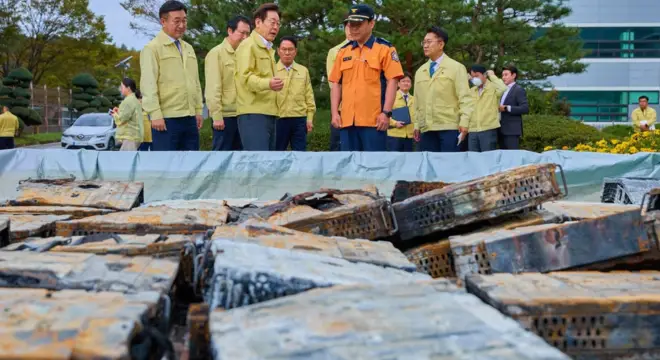In a month, South Korea experienced a major problem in its digital infrastructure when there was a fire at the National Information Resources Service (NIRS) in Daejeon. Hundreds of government services were interrupted, impacting citizens’ ability to perform basic online administrative applications. Who would have thought fire at the state data center could derail 700 or more government services? Fast forward to today, how quickly are services coming back, and how do we stop this from occurring again?
Here we dive into the ongoing recovery and what the disruptions mean for South Korea’s digital infrastructure.
The Fire That Shook Government Services
On September 26, 2025, a fire broke out in a server room at NIRS, ignited by the explosion of a lithium-ion battery. This fire brought operations to a complete standstill and generated catastrophic disruptions to many parts of the government’s online services. It took fire crews hours to regain control of the situation, and it took all of the next day for the fire crews to stamp out the fire completely.
Public authorities were quick to assess the damage after the fire was fully extinguished, coming to realize the fire had impacted 709 online government services, from essential administrative portals to minor information services. The consequences of the event surprised citizens and inspired questions on the resiliency of South Korea’s digital infrastructure.
The most seriously impacted services included:
- The Public Procurement Service website
- The Ministry of Culture’s administrative systems supporting Korea’s cultural centers.
- The voucher settlement system from the Ministry of health and Welfare
This incident started considerations about vulnerabilities in the government systems managing data, and began discussions on disaster preparedness for digital state-operated services
Restoration Progress – How Much is Back Online?
Officials have been working hard and diligently to restore services online. As of October 12th, 2025, 260 of the 709 services affected have been restored, a total recovery rate of 36.7%.
Looking at this by priority:
- Grade 1 Services (most essential) – 30 of 40 restored → 75% recovery
- Grade 2 Services – 51.5% restored
The recently restored systems include both the Cultural Ministry administrative portals, the Public Procurement Service websites, and the health voucher settlement tool, allowing citizens some time to return to online activities again.
While all services are recovering as expected, progress in restoring lower priority services (Grade 3 and 4) needs more focus. Officials are still monitoring the process closely.
Government Response and Investigations
The Central Disaster and Safety Response Headquarters has been leading efforts to respond and recover restoration efforts, and prioritized services with higher impacts on citizens that depend on government administrative elements.
At the same time, police are investigating the cause of the fire, which started from an explosion of a lithium-ion battery. At this point, it is believed the explosion from that battery stemmed from an uninterruptible power supply, a necessary device to keep servers powered.
President Lee Jae Myung visited the NIRS location on October 10, 2025 to assess the damage and restoration efforts. He believes restoration efforts are substantial; however, citizens should still be diligent in their use of government digital systems, to ensure safety and reliability.
Integration With Ongoing Reports
Naturally, the article is related to earlier reporting, such as articles like “South Korea in Crisis: North and Irm Fire Related to Government Services System”, which talked about the ways the fire affected citizens and government services at the time reporting was presented.
By the time you read the previous report, particularly with the skimming and cognitive load that occurs, you will have an even better understanding of the relevant context: that is, the story arc from the means of disruption, we meaningfully continued this into the present reporting on reconstruction.

Impact on Citizens and Businesses
Citizens and businesses that rely on digital government services for their routine administrative activities were impacted by the fire. Applications associated with procurement, registration for cultural programs, and the health voucher program were not available for a time. Many citizens experienced delays in official administrative processes, highlighting the need for disaster planning and preparedness for online systems for administering government services.
Business operators that rely on public procurement platforms were especially disrupted. Businesses could not submit bids nor obtain important public procurement information, which hindered their ability to conduct their operations effectively. Even with some relief that those services have returned, the experience has highlighted that reliance on digital administrative government services is precarious.
Preventive Measures and Lessons Learned
Authorities are now taking steps to prevent future incidents:
- Enhanced monitoring of lithium-ion battery systems to prevent explosions.
- Regular safety audits for state data centers.
- Backup systems and disaster recovery protocols to minimize service downtime in emergencies.
Experts suggest that this incident serves as a wake-up call for modern governments relying heavily on digital infrastructure, stressing the importance of redundancy and proactive safety measures.

What’s Next – Remaining Services
While high-impact services are back on-line, Grade 3 and 4 services are still offline while a timeline for recovery is developed. A timeline is not yet provided.
All residents and businesses are asked to continue to monitor official updates for the status of the services they rely on. The government will work to improve communication in a future extreme incident like this.
Conclusion – Recovery in Progress, Vigilance Remains
The recovery of 36.7% of online government services is an important point in South Korea’s digital recovery after the fire at NIRS. Most high-priority systems are back up and running for citizens and businesses to use and resume normal essential work. Authorities remain vigilant, investigating the cause of the fire and attempting to restore other online service systems as soon as possible.
As South Korea responds to a digital challenge, it expresses cues of capability, safety, and communication. Citizens are beginning to resume their normal online activities; however, authorities must continue to monitor this emerging risk while implementing preventive measures to prevent future disruption.


